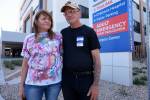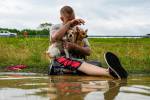Bus shelter tragedies sadden, but don’t surprise, those who know better
Patricia Hoff was an ordinary working person employed at a local Lowe's hardware store. She was the kind of person you'll find living at a local Budget Suites, the kind you'll see riding the CAT bus.
When a tottering Steven Murray slammed his Dodge pickup into a Boulder Highway bus stop Monday, killing the 55-year-old Hoff and severely injuring 26-year-old Porsche Hughes, it became tragically clear that improving the safety of the Citizens Area Transit shelters remains a work in progress.
With Murray's long history of driving while intoxicated, surely he's responsible for his own actions in this tragedy.
But I'm left wondering how safe Southern Nevada's bus stops would be if the white-collar class commuted via the CAT system.
Around these parts, ordinary people ride the bus out of economic necessity: shift workers and senior citizens, high school kids and the disabled. They've been joined recently by citizens pinched by rising gasoline prices.
Regional Transportation Commission General Manager Jacob Snow says his agency has made great progress in improving safety at bus stops, which of necessity are constructed near busy roadways often just a couple feet from speeding traffic.
Only in recent years has the RTC had jurisdiction over where the stops would be placed and how the shelters would be constructed. Everything from property rights to conflicting political jurisdictions have slowed progress on making the bus shelters as safe as possible, Snow observes.
"When I first came to the RTC, we had no legal jurisdiction to really do anything at any bus stop," he says. "Legally, it was under the power of the county or the city. That was a frustrating thing for us."
Legislative changes in 2005 and 2007 have clarified the jurisdictional issues, Snow says, but it's clear the frustration continues.
Moving bus shelters retroactively is expensive and can generate property rights disputes, he says.
While the public is reminded of the safety questions only when an addled motorist kills poor souls waiting to catch a cross-town bus, the RTC has long been aware of the bloody issue. Its own Accessibility Guidelines mention it in specific detail.
Although a district judge determined in a civil case that the guidelines weren't actual regulations, and thus didn't have to be adhered to, a number of Southern Nevada's bus stops also don't measure up to standards recommended by the Americans with Disabilities Act.
The recommendation, by the way, is an eight-foot separation from the start of a wheelchair ramp to the curb, placing the bus stop much farther from traffic.
There have been plenty of critics of bus shelter safety in Southern Nevada.
Traffic engineer Ronald Shields and accident reconstruction specialist Gary Hesler were hired by attorney Matthew Callister in 2007 to analyze a bus stop near the intersection of Smoke Ranch Road and Rock Springs Drive that was the scene of the horrific March 14, 2005, accident in which motorist Veronica Schmidt killed four persons waiting for the CAT.
Other fatal accidents occurred at bus stops in 2004, 2003, and 2002.
In his affidavit, Shields wrote, "Since the early 1990s, it has been the accepted custom, standard, and practice in the industry to place and position bus shelters so that there is a minimum clear length of eight feet, measured from the curb or vehicle roadway edge to the back of the shelter. ... One of the core purposes ... is to improve the overall safety of roadways and bus shelters by placing the bus shelters further away from the roadways, and subsequently getting pedestrians further away from traffic and out of harm's way."
Hesler wrote, "Based upon my investigation, I conclude further that had there been eight feet of clearance between the curb and the back of the bus shelter involved in this accident, it is more likely than not that some and possibly all of those struck and killed could have and would have had enough room to get out of harm's way and avoid the collision."
"It's a tragedy," Callister says of the recent fatality. "But it's a tragedy that's foreseeable. The people who use public transit are working-class people. They're not the rich and mighty of the town who are suffering. It's a real, preventable tragedy."
It's one that keeps repeating itself.
How many more ordinary people will be killed before the changes are made?
John L. Smith's column appears Sunday, Tuesday, Wednesday and Friday. E-mail him at Smith@reviewjournal.com or call (702) 383-0295.























